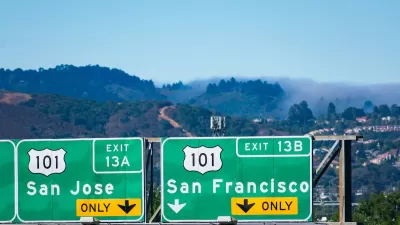The SPUR Regional Strategy sets a new standard for planning advocacy, not only for the depth and breadth of its vision, but for its skill in execution.

SPUR released an ambitious, colorful new Regional Strategy this week that sets a new standard for planning advocacy.
The results of three years of work includes policy research and analysis on housing, growth, economic justice, climate, and transportation—all supplemented with digital storytelling created by Art+Action in collaboration with Emotive Brand. At least 20 artists, designers, animators, and other creatives contributed to the report, according to the report's credits.
The entire SPUR Strategic Vision is organized into four "invitations": 1) Reimagine our housing policies; 2) Grow up, not out; 3) Close the racial wealth and well-being gap; and 4) Protect our region and all its inhabitants from climate change. A total of 25 reports comprise the entire SUPR Regional Plan.
As for the substance of the SPUR Regional Strategy, San Francisco Chronicle reporter J.K. Dineen offers this summary:
The Bay Area of 2070 would be a place where homeless encampments are a thing of the past. Builders would be allowed to construct three- or four-unit buildings in suburban single-family neighborhoods. Speculators would no longer be able to evict tenants in order to convert apartments to condos.
And new housing would not gobble up precious farm land in counties like San Joaquin or Contra Costa, but would be built mostly in five-story buildings in historic downtowns like Alameda, Fairfield, Mountain View, Pleasanton and Santa Rosa.
As Dineen explains, the Regional Strategy lays out a 50-year vision for the region, with 175 policy recommendations in all, touching "on everything from rent control to rapid bus lines to protecting against sea level rise."
"The SPUR reports compare two scenarios: 'business as usual,' based on current zoning and land-use patterns; and a 'new civic vision,' which imagines a more equitable and sustainable region with reformed land-use regulations," according to Dineen. The new civic vision referenced here is laid out in its own separate document available online.
The report plans for 4 million new residents in the Bay Area by 2070, and targets a need for 2.2 million new housing units. The "business as usual" land-use planning in place in the cities and counties comprising the region would likely produce 1.4 million housing units, explains Dineen, "and much of that would be put in the wrong places — farmland and open areas that are far from transit."
Dineen's article, linked below, includes a lot more detail on the differences between the business-as-usual approach and the new civic vision outlined by SPUR.
FULL STORY: Could the Bay Area solve its housing crisis by building in city centers? An S.F. group thinks so

Maui's Vacation Rental Debate Turns Ugly
Verbal attacks, misinformation campaigns and fistfights plague a high-stakes debate to convert thousands of vacation rentals into long-term housing.

Planetizen Federal Action Tracker
A weekly monitor of how Trump’s orders and actions are impacting planners and planning in America.

In Urban Planning, AI Prompting Could be the New Design Thinking
Creativity has long been key to great urban design. What if we see AI as our new creative partner?

King County Supportive Housing Program Offers Hope for Unhoused Residents
The county is taking a ‘Housing First’ approach that prioritizes getting people into housing, then offering wraparound supportive services.

Researchers Use AI to Get Clearer Picture of US Housing
Analysts are using artificial intelligence to supercharge their research by allowing them to comb through data faster. Though these AI tools can be error prone, they save time and housing researchers are optimistic about the future.

Making Shared Micromobility More Inclusive
Cities and shared mobility system operators can do more to include people with disabilities in planning and operations, per a new report.
Urban Design for Planners 1: Software Tools
This six-course series explores essential urban design concepts using open source software and equips planners with the tools they need to participate fully in the urban design process.
Planning for Universal Design
Learn the tools for implementing Universal Design in planning regulations.
planning NEXT
Appalachian Highlands Housing Partners
Gallatin County Department of Planning & Community Development
Mpact (founded as Rail~Volution)
City of Camden Redevelopment Agency
City of Astoria
City of Portland
City of Laramie





























